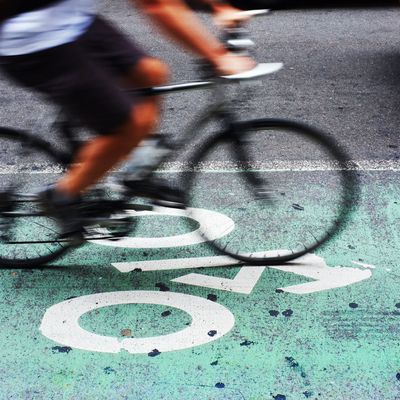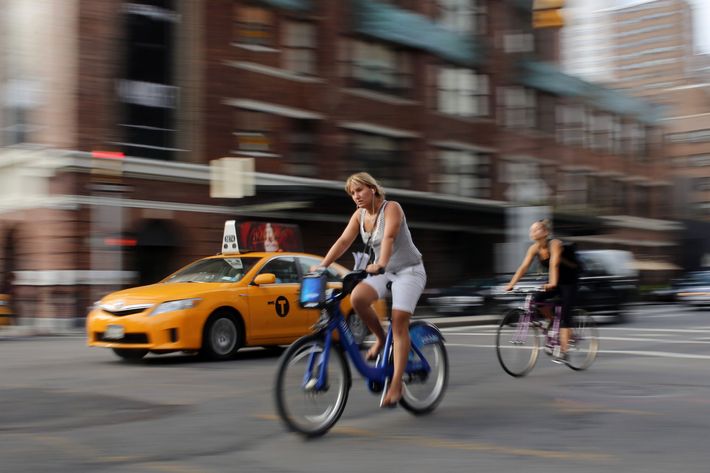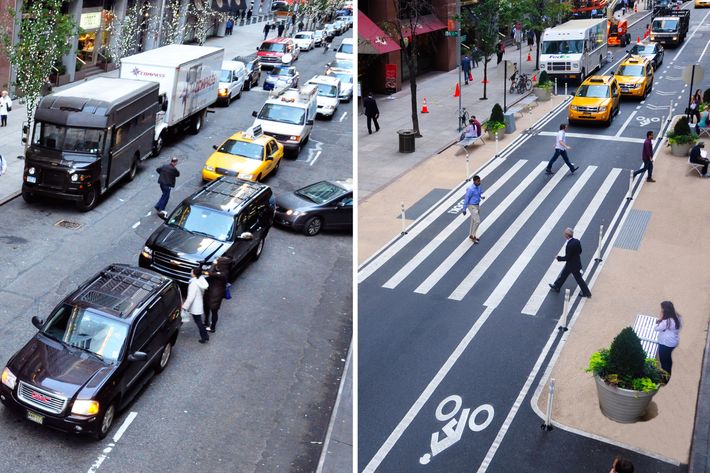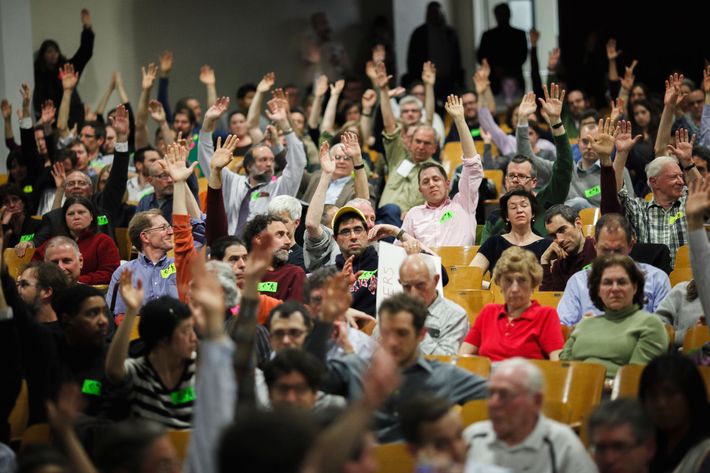
Never underestimate the anger directed at bicyclists. They ride too fast, terrorizing pedestrians. They ride too slow, dangerously obstructing drivers. They don’t wear helmets or reflective bike gear, jeopardizing themselves. They shouldn’t ride in streets, which are hostile, car-only zones. They shouldn’t have their own lanes because there aren’t enough of them to take away space from cars. Yet there are so many of them that they’re running down pedestrians and therefore shouldn’t ride on sidewalks.
The antipathy extends to the painted lanes that bikers ride on. Bike lanes don’t simply rob taxpaying motorists of driving space that they bought and paid for. They seem to reward bike riders for their bad behavior. And bike lanes are a dangerous lure, giving would-be riders a false sense of security that it’s safe to ride on streets. “What I compare bike lanes to is swimming with the sharks,” former Toronto council member Rob Ford said in 2010. “Sooner or later you’re going to get bitten. And every year we have dozens of people that get hit by cars or trucks. Well, no wonder: Roads are built for buses, cars, and trucks, not for people on bikes. My heart bleeds for them when I hear someone gets killed, but it’s their own fault at the end of the day.”

When I became New York City’s Transportation commissioner in 2007, our streets had only 220 miles of bike lanes, and you might not have noticed any of them. The city was the first in the nation to designate them — in 1894, along ocean Parkway — but it had, over its history, soured on them. One of the first things Ed Koch tried to do as mayor in the 1980s was install barrier-protected lanes, but New Yorkers roundly blasted the plan and he quickly ripped them out.
Politicians learned the lesson: Bikes were bad politics. Voters are drivers angry about congestion and convinced bikers are the ones causing all the traffic. (Never mind that from the transportation planner’s perspective, drivers are never stuck in traffic. They are the traffic they are stuck in.) Voters are pedestrians who swap stories about being nearly killed by an aggressive, wrong-way-riding, Lycra-clad ninja cyclist. (A pedestrian killed by a cyclist is guaranteed front-page news status for days on end, while a pedestrian killed by a car rarely registers.)
When I accepted Mayor Bloomberg’s offer to become Transportation commissioner, I told him I wanted to change the city’s transportation status quo. The DOT had control over more than just concrete, asphalt, steel, and striping lanes. These are the fundamental materials that govern the entire public realm and, if applied slightly differently, could have a radical new impact. I saw no reason why New York couldn’t become one of the world’s great biking cities — or why it wouldn’t want to. But the act of actually achieving it launched the bitterest public fight over transportation in this city since Jane Jacobs held the line against Robert Moses’s Lower Manhattan Expressway half a century earlier. By the time the fight localized — in October 2010, when police attempted to control hundreds of dueling protesters for and against a new bike lane along Prospect Park — The Brooklyn Paper called the proposal “the most controversial slab of cement outside the Gaza Strip.”
++
In my first months on the job in 2007, I visited Copenhagen to see how the Danes build bikeways. We toured the city with Jan Gehl, the globally influential architect and urban planner. Gehl pioneered the idea of designing cities from the perspective of pedestrians and cyclists. This perspective, according to Gehl, generates the kind of intimacy and street life that makes cities attractive places.

When I returned we moved quickly to implement many bike lanes protected by a lane of parked cars. Part of what was so appealing about bike lanes as a transportation solution is that they are a lot easier and cheaper to install than new subways. The main construction material is paint, which simplifies the amount of technical and bureaucratic work necessary to design a good one. And using paint is only part of what makes them incredibly cheap, since federal clean-air funds could be used to pay for 80 percent of the bike lane expenditures. We got buy-in from the city’s fire commissioner, who had no problem figuring out that the designs left ample room for their companies. (It helped that his chief deputy was a bike enthusiast.) Police Commissioner Ray Kelly was instrumental in getting his department to sign off on changes to signs, traffic flow, and enforcement. (The changes were not exactly popular with the department rank-and-file.)
By October 2007, we had installed the first parking-protected bike lane in North America on Ninth Avenue. Many New Yorkers — even within the DOT — thought it was crazy. They were so used to their streets that they had no idea they could be changed, and the idea of riding a bike was foreign. Some believed that bike lanes cut the space needed to process traffic and to park. Some businesses feared the lanes would make it harder to get deliveries. Others objected that the lanes disrupted the street code that delineated where pedestrians and cars were supposed to be. The street might be dangerous, it might be inefficient, oppressive, and counterproductive, but New Yorkers were used to it.
Yet the successful installation of the first bike lane — and the initial lack of opposition — led to a series of rapid-fire projects, with new bike lanes set in motion on nearby Eighth Avenue; Vernon Boulevard along the Western Queens waterfront; in the Greenpoint neighborhood of Brooklyn; on Staten Island’s Bay Street; and Grand Concourse in the Bronx; plus a vital, interconnected system of feeder bike lanes connecting the East River bridges to local bike lane networks in Manhattan and Brooklyn. By 2009 we had completed the most rapid installation of bike lanes ever executed in any city, repurposing former car space to create 200 miles of bike lanes in three years. Jan Gehl would later remark that more lanes were built during this transformative period in New York City than in 50 years in bike-friendly Copenhagen.
Then the backlash began.
One of the first bike-lane battles ignited on Grand Street. We converted the existing on-street bike lane into a bike path placed at the curbside, and we pushed the parking lane away from the curb, creating a Ninth Avenue–style floating lane and a protected bike lane. The street still had one moving lane, two parking lanes, and a bike lane, simply in a different order that all but eliminated the possibility of double-parking. Still, merchants and local residents claimed that we had removed a traffic lane and also eliminated a parking lane, a claim repeated by reporters despite clear, photographic evidence that this wasn’t the case. Mayoral candidate Bill Thompson, sensing an easy political win, declared, “I’m in favor of bike lanes but you can’t put bike lanes in without speaking to the community.” (In fact, the bike lane had been duly presented to the local community board, which supported the project in a 33–1 vote.) The Fire Department said the lane had no impact on their trucks’ response times, but anonymous firehouse sources allegedly claimed that the bike lane is “a problem.”

In Williamsburg, the community board voted 39–2 in favor of building a bike path on Kent Avenue, but construction made it difficult for trucks to load or receive deliveries. Worse, there was the issue of women. On bikes. They were lured by bike lanes to Williamsburg’s neighborhoods of observant Jews dressed year-round in conservative, body-covering outfits. “Hasid Lust Cause” read the headline. “It’s the Hasids vs. the hotties in a Brooklyn bike war.” Reporters fanned out all along Kent Avenue to shoot pictures of the Ladies of the Lanes, no doubt because the lanes “are popular with North Williamsburg hipsters — many who ride in shorts or skirts.”
But the biggest controversy of all was centered on an otherwise quiet street, Prospect Park West, a tree-lined boulevard home to upscale co-ops and multi-million-dollar town houses. In part to address chronic speeding, which made the street feel more like a highway, we redesigned the street to accommodate a two-way protected bike-path. The community board voted to support the proposal. And then:
“She is a zealot!” came the voice on a local radio station one morning. The deep, Brooklyn-blunt voice was unmistakably that of the borough’s president, Marty Markowitz. The “she,” I realized over my morning coffee, was me. “I have supported bicycle lanes, throughout the borough,” Markowitz continued. “But where I feel bicycle lanes would have an adverse effect my job is to speak up for it.” Speaking with a reporter in a local paper, Markowitz questioned, “What is our objective in this city? To stigmatize the use of cars? To make it difficult to park? Do we want Brooklyn to replicate Amsterdam?” With the “zealot” thing, Markowitz shifted the terms of the debate. The impending construction of a bike lane on Prospect Park West, Markowitz’s turf, wasn’t a safety issue or a neighborhood-requested project. It was about me and my purported personal war against cars.
Despite Markowitz’s pre-construction denunciation, the building of the bike lane in Prospect Park West went ahead in the early summer of 2010 with little drama. We had heard that some locals planned strategy sessions to mount an organized opposition to the lane, but nothing much materialized that summer.
By July, when the paint on the lane was still barely dry, Prospect Park West was a different street. None of the prophesied traffic pileups came to pass, no chain-reaction crashes, no reports of people mowed down by bike riders in the lane. Anyone watching the street might be lulled to sleep by the gentle traffic cycles. We succeeded in making the street better for everyone.
Enter two groups of local residents, Seniors for Safety and Neighbors for Better Bike Lanes, both apparently formed for the sole purpose of opposing the Prospect Park West bike lane. Such great names. Who could be against seniors or safety, or oppose neighbors who want better bike lanes? In the new lane these groups saw an aesthetic calamity that spoiled the grand avenue and made it harder for people crossing the street to see oncoming cars and bikes. A better alternative, they offered, would be a two-way bike lane on a road within Prospect Park itself. There were three major holes in this modest “compromise.” Putting the lane inside the park would do nothing to reduce speeding on Prospect Park West or prevent people riding bikes on the sidewalk, the project’s two original goals. And there was only one bike-accessible park entrance on the street between the extreme ends of the park. Riders would need a new bike lane on the street just to reach the bike lane in the park. This would be capitulation, not compromise.
In the bike lane’s fledgling months, these two groups cobbled together a strategic campaign against the lane, targeting reporters and news outlets. The anti-laners alleged that we had dodged community notification and approvals. (Not true; in fact, it was arguably the most thoroughly vetted and enthusiastically supported bike lane in human history.) Newspapers and local blogs ginned up the drama. Anyone who learned about Prospect Park West from the headlines might think that children were being run over by city bulldozers and speared by bike riders carrying lances. “It’s a Bike Lane War on Prospect Park West!” “Bike Lane Controversy Spurs Shouting Match.” “Pedestrians Argue That Zippy Cyclists on Prospect Park West Bike Lane Put Safety at Risk.” “Surging bike ridership has created a simmering cultural conflict,” the New York Times reported, with bike lanes in particular leading to “unusual scenes of friction.” By December, I was summoned to the New York City Council’s transportation committee for a packed public hearing that amounted to a cross-examination.
The next month, Assistant Commissioner for Traffic Management Ryan Russo attended a meeting in a Park Slope church two blocks from the lane. Relying on the data about how the street had held up in the months since the lane had been installed, he was ready to answer questions from the community board that requested the project and ready to face the dozens of bike-lane supporters who came out in force alongside a cadre of anti-laners.
The anti-laners had tried to establish their own traffic-safety narrative in a letter to the New York Times. “When new bike lanes force the same volume of cars and trucks into fewer and narrower traffic lanes, the potential for accidents between cars, trucks and pedestrians goes up rather than down,” they wrote. “At Prospect Park West in Brooklyn … our eyewitness reports show collisions of one sort or another to be on pace to be triple the former annual rates.”
While their eyewitness reports painted a dismal picture, statistics told a far different story. Russo clicked through the presentation as reporters lurked around the auditorium. Speeding on the corridor — the original impetus behind the project — bottomed out, from 74 percent of cars on Prospect Park West speeding before to just 20 percent after. Sidewalk bike riding dropped from 46 percent of riders on the sidewalk before the project to just 4 percent after. The number of crashes actually resulting in injuries dropped 63 percent. Traffic volumes and driving time remained unchanged. A survey conducted by Brad Lander, the community-minded council member for Prospect Park West’s district, found that most people surveyed who lived near the park supported the changes.
The opponents at the meeting were strangely muted, their arguments not finding much support from the board or from the public. That night, we celebrated a successful meeting that had gone even better than our best-case scenario. It looked like the lane was there to stay.
The community board said it was going to review the data we presented and issue a resolution regarding the lane’s future. Opponents of the lane were also looking at the data that night and had already given their take on it to a reporter. “B’klyn Nabe Disputes Lane ‘Success’” read the next day’s tabloid headline. The story continued: “A battle over a Brooklyn bike lane is in high gear,” with a group of well-organized residents accusing the city of “fudging the numbers of bicycles using the lane to support the city’s drive to make the pathway permanent.” No mention of the community request or support for the lane. Opponents of the lane had collected their own “data” (video of the lane shot from the penthouse of a resident) and said they saw vastly fewer riders in the lane than our counts. Their counts were collected at only one extreme end of Prospect Park West, the equivalent of counting the number of passengers riding a train by counting how many are on at the last stop, but the tactic played well in the media and riled up bike-lane opponents. The underlying bike-lane battle wasn’t a factual, data-based argument but a cultural and political fight that was rapidly devolving into a backlash, one that, as we soon discovered, would wind up in New York’s court system.
The bike backlash of early 2011 were the toughest months I’ve ever endured professionally. Newspapers, radio stations, and blogs delivered damning quotes from shopkeepers, people in cars, schoolteachers, and crossing guards to inflame the debate. We were accused of ignoring community views and ramming projects down communities’ throats, making streets dangerous and killing businesses. Every day brought new stories of misery, not just about Prospect Park West but about every bike project old or new, plazas already constructed, and phantom projects that hadn’t even been proposed.
A reporter questioned a bike-lane project on Manhattan’s Second Avenue that ran near the Israeli consulate. “Imagine if the man on the bike was a terrorist!” John Cassidy of The New Yorker claimed that our polices represented the views of “a small faddist minority intent on foisting its bi-pedalist views on a disinterested or actively reluctant populace.” In the New York Post, Cindy Adams dubbed me the “wacko nutso bike commissioner.” Blistering critiques of the bike backlash and my starring role in it fueled a major story in the Times. The lead quote in that piece came from Anthony Weiner, at the time a candidate for mayor, who said that during his first term, “I’m going to have a bunch of ribbon-cuttings tearing out your fucking bike lanes.” The backlash landed on the cover of this magazine with a photo illustration containing every urban street-fight cliché: two aggressive men riding bikes the wrong way; horrified pedestrians; a car blocking a bike lane; and the headline “Not Quite Copenhagen. Is New York Too New York for Bike Lanes?”
Opponents of the Prospect Park West bike lane took to the courts, filing legal papers that claimed the transportation department’s decision to build the bike lane was “arbitrary and capricious.” The suit accused the department of giving false or misleading bike-lane data to the public and claimed that the lane should have been studied for “various environmental impacts, including but not limited to exhaust and noise pollution,” and possible violations of the city’s landmarks preservation code.
When you disrupt the status quo, you need a boss who is willing to take the heat when the critiques come. Fortunately, I had one in Mayor Bloomberg. I was worried for my job, but as the stories mounted, the administration closed ranks. The newspapers that had hoped to harass the mayor into firing me and tearing out the bike lanes were bitterly disappointed. “I’ve always said that if you want lifetime employment in our administration, you just get the tabloids to demand that I fire you,” he said. The Post responded in kind with a sarcastic, reverse-psychology editorial entitled “We ♥ Janette,” demanding that I be kept on as commissioner. “This one’s a keeper,” it concluded. “Pleeeeease don’t fire her.”
++
He didn’t. I kept that editorial at my desk for the remainder of my tenure. As the Winter of Bike Discontent thawed into spring, there were fewer hit pieces, and broadcast media moved on to other drive-by topics. The advocacy community also pulled together, just as they had at Prospect Park West. Paul Steely White and Caroline Samponaro from Transportation Alternatives spoke out at community meetings, drafted op-eds and letters to the editor, and always made themselves available to reporters writing about bike controversies. Supporters delivered 1,700 letters at an event on the City Hall steps, thanking the mayor for the string of street changes. They were led by savvy leaders like Kate Slevin, of the Tri-State Transportation Campaign; and Gene Russianoff, from New York’s Straphangers Campaign; and backed by officers of the Natural Resources Defense Council and the New York League of Conservation Voters.
There may have been a more practical explanation for the end of the media frenzy: The polls started coming in. A Quinnipiac University poll found that 54 percent of New Yorkers said that bike lanes were “a good thing.” This was the first of many polls that would be released in the coming months, two putting bike lanes’ popularity as high as 66 percent — higher than the approval numbers for the politicians who railed against the lanes. Judged by the polls, what had sounded like a chorus of opposition in the media was actually a small but determined section of the population.
It became clear that we didn’t win the public debate by outwitting the opposition. The battle was won by the projects and by New Yorkers themselves. New Yorkers were way ahead of the press and the politicians. They took to changes on the street with an enthusiasm immune to the government that built them, to the advocates pushing for the changes, and to the opponents arrayed against them. They were just looking for new ways to get around and saw in the transformation of the streets the fulfillment of a long-dormant promise. Change is possible. They weren’t Lycra warriors or ideologues out for blood, and in fact there was less blood on the street than there was at the start of the process. And it wasn’t about bike lanes. It was about an idea about our streets and who they are for.
We succeeded in building as many bike lanes after the bikelash as before it. The number of riders doubled from 2007 to 2013, representing a fourfold increase measured over a decade. We launched Citi Bike in the final months of our time in office. The system is in the process of doubling in size and has surpassed 25 million rides in less than three years, part of a quadrupling in bike ridership citywide since 2000. New York now has more than 1,000 miles of bike lanes, and Bicycling magazine named us the nation’s best biking city for the first time ever.
None of the bike-lane opponents’ predictions has come to pass. City streets have never been safer, more economically thriving, or offered more transportation options than they do today. My successor as Transportation commissioner is greatly expanding the network of bike paths and doubling the size of the city’s bike-share system.
One relic of the Great Bikelash remains. Last month, attorneys entered a Brooklyn courtroom to hear arguments in the as-yet-undead lawsuit over the Prospect West bike lane. I and others testified to defend the nearly six-year-old lane, which has become one of the most scrutinized, studied, and successful projects not just in New York but on any city street. Yet the lane remains the most in peril of being erased at the hands of the case’s plaintiffs, who inexplicably clutch at the last remnant of their case. Sometimes a bike lane is just a bike lane, but this one is also a moribund metaphor for the fights that cities across the nation face when reclaiming and resetting their streets.
When you push the status quo, it pushes back, hard. Everyone likes to watch a good fight. And the battle over bike lanes most surely was a street fight: politically bloody and ripped from the tabloids. Call me biased, call me crazy — many people have — but I’ll tell you this: The bikes, and all New Yorkers, won.
From Streetfight: Handbook for an Urban Revolution by Janette Sadik-Khan and Seth Solomonow, published by Viking, an imprint of Penguin Publishing Group. Copyright © 2016 by Janette Sadik-Khan and Seth Solomonow.





























